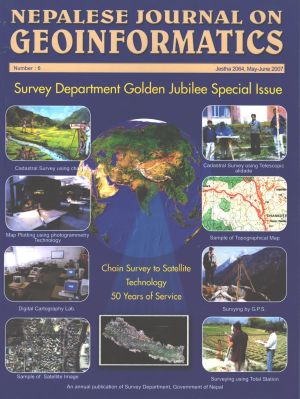Astronomy And Gravity Surveying In Nepal
DOI:
https://doi.org/10.3126/njg.v6i1.51219Keywords:
Astronomy, Gravity, NepalAbstract
Astronomical observations and gravity measurements were carried out in Nepal along the boundary since 1800. They are very important due to high deflection of verticals with irregular variation. It is also impractical to carry out precise levelling with conventional method due to large variation of relief at a short distance. Absolute gravity points are established in Siddharthanagar- Pokhara and Eastern part of Nepal in 1996 with micro gal accuracy. The gravity observations carried out on first order and some GPS stations. Gravity and astronomical observations are necessary in GNSS method of establishment of control points to compute orthometric (geoidal) heights.
Astronomical observations of points are useful to calculate deviation of verticals to determine the GPS heights, controlling the geodetic network and change in longitude, latitude and azimuth of control points and crustal and local dynamics. The fixed astronomical observatories are now used to determine the precise positioning of points.
Astronomical observations carried out in Nepal since the Prehistoric era. Chhatedhunga (stone hinges) are visible all over in hills of Nepal. The book Sumati Tantra" in 576-880 and "Sumati Shidhanta" written 1409 written and later in Sanskrit and Nepali. However, no modern survey records are available of astronomical and gravity observations for survey work before 1924.
The first survey of Nepal carried out astronomical and gravity observations in 1924-27 to produce 1=" 4 mile maps and in 1950-58 to produce 1"= 1 miles maps, were produced. Base line and astronomical observations carried out during boundary survey 1960-61. After establishmentof Geodetic and Astronomical Branch on Survey Department, modern astronomical observations werecarried out using astronomical theodolites like Wild T4, DKM3 /Circum Zenithal manually to determine the latitude, longitude, azimuth and deviation of verticals in 1970-90.
Geodetic astronomy will be used in future to determine deviation of verticals to determine precise height, geoidal spheroidal separation and cm or better height determination. Geodetic total station, digital imaging sensor, GPS for timing and determination of geodetic coordinates, and personal computer will be used in the field.
Gravimetry will be extensively used in determination precise coordinate, geopotential datum instead of mean sea level and geoidal spheroidal separation. The absolute and relative gravimeters using digital technology are available of mgals (1 mgal= 3.25 mm of height) precision.
Nepal is facing same problem of lack of dense control points point with required accuracy as in 1970s where topographical control points with accuracy of 2-18 m and at 25 Km interval and lack of surveyors and draftsmen. The 0.5 -1m accurate and at about 1 Km distance plannimetric control points was the requirement of that time for cadastral mapping. The plannimetric and height control points of cm accuracy and at about 5 Km distance for digital mapping, and environmental and infrastructural development works, and survey graduates to operate the modern automatic instruments and technologies are the requirement of present time.
It is recommended that the survey Department conduct study to strengthen the Nagarkot observatory and first and second order control networks and provide cm accuracy control points on urban areas, and level network on Himalayan Region.




